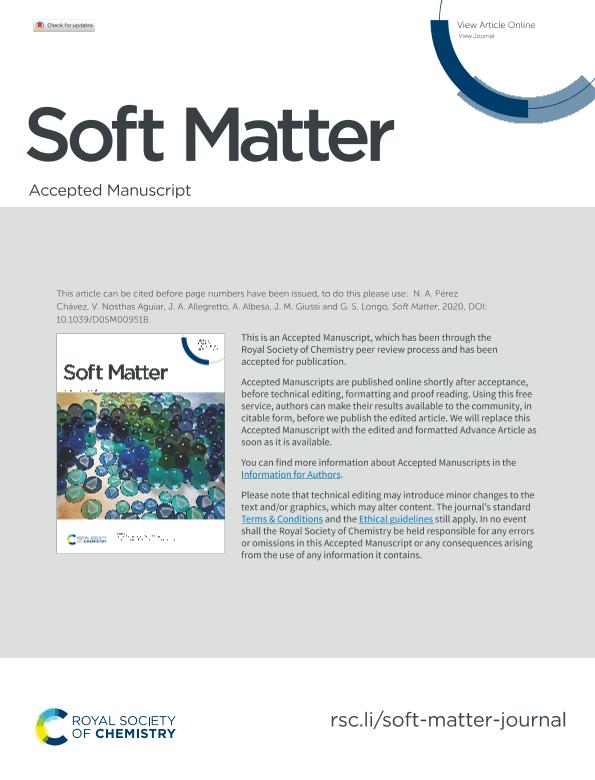Mostrar el registro sencillo del ítem
dc.contributor.author
Pérez Chávez, Néstor Ariel

dc.contributor.author
Nosthas Aguiar, Victor
dc.contributor.author
Allegretto, Juan Alejandro

dc.contributor.author
Albesa, Alberto Gustavo

dc.contributor.author
Giussi, Juan Martín

dc.contributor.author
Longo, Gabriel Sebastian

dc.date.available
2021-09-28T15:01:37Z
dc.date.issued
2020-07-14
dc.identifier.citation
Pérez Chávez, Néstor Ariel; Nosthas Aguiar, Victor; Allegretto, Juan Alejandro; Albesa, Alberto Gustavo; Giussi, Juan Martín; et al.; Triggering doxorubicin release from responsive hydrogel films by polyamine uptake; Royal Society of Chemistry; Soft Matter; 16; 32; 14-7-2020; 7492-7502
dc.identifier.issn
1744-683X
dc.identifier.uri
http://hdl.handle.net/11336/141719
dc.description.abstract
Polyamines such as putrescine, spermidine and spermine are required in many inter- and intra-cellular processes. There is, however, evidence of anomalously high concentrations of these polyamines around cancer cells. Furthermore, high polyamine concentrations play a key role in accelerating the speed of cancer proliferation. Some current therapies target the reduction of the polyamine concentration to delay the cancer advance. In this study, we use a molecular theory to prove the concept that poly(methacrylic acid) (PMAA) hydrogels can play the dual role of incorporating and retaining polyamines as well as releasing preloaded drugs in response. Towards such a goal, we have developed a molecular model for each of the chemical species, which includes the shape, size, charge, protonation state, and configuration. Our results indicate that PMAA hydrogel films can incorporate significant amounts of polyamines; this absorption increases with the solution concentration of the polyamines. Doxorubicin was chosen as a model drug for this study, which can be successfully incorporated within the film; the optimal encapsulation conditions occur at low salt concentrations and pH values near neutral. Polyamine absorption within the film results in the desorption of the drug from the hydrogel. An increase in the concentration of the polyamines enhances the drug release. To validate our theoretical findings, poly(methacrylic acid) hydrogel thin films were synthesized by atom transfer radical polymerization. Absorption/desorption experiments followed by UV-Vis spectroscopy demonstrate doxorubicin encapsulation within these films and polyamine-dependent drug release. This journal is
dc.format
application/pdf
dc.language.iso
eng
dc.publisher
Royal Society of Chemistry

dc.rights
info:eu-repo/semantics/openAccess
dc.rights.uri
https://creativecommons.org/licenses/by-nc-sa/2.5/ar/
dc.subject
Calculation
dc.subject
Hydrogel
dc.subject
Doxorubicin
dc.subject
Polyamines
dc.subject.classification
Físico-Química, Ciencia de los Polímeros, Electroquímica

dc.subject.classification
Ciencias Químicas

dc.subject.classification
CIENCIAS NATURALES Y EXACTAS

dc.title
Triggering doxorubicin release from responsive hydrogel films by polyamine uptake
dc.type
info:eu-repo/semantics/article
dc.type
info:ar-repo/semantics/artículo
dc.type
info:eu-repo/semantics/publishedVersion
dc.date.updated
2021-09-06T17:25:42Z
dc.identifier.eissn
1744-6848
dc.journal.volume
16
dc.journal.number
32
dc.journal.pagination
7492-7502
dc.journal.pais
Reino Unido

dc.journal.ciudad
Cambridge
dc.description.fil
Fil: Pérez Chávez, Néstor Ariel. Consejo Nacional de Investigaciones Científicas y Técnicas. Centro Científico Tecnológico Conicet - La Plata. Instituto de Investigaciones Fisicoquímicas Teóricas y Aplicadas. Universidad Nacional de La Plata. Facultad de Ciencias Exactas. Instituto de Investigaciones Fisicoquímicas Teóricas y Aplicadas; Argentina
dc.description.fil
Fil: Nosthas Aguiar, Victor. Universidad Nacional de La Plata; Argentina
dc.description.fil
Fil: Allegretto, Juan Alejandro. Consejo Nacional de Investigaciones Científicas y Técnicas. Centro Científico Tecnológico Conicet - La Plata. Instituto de Investigaciones Fisicoquímicas Teóricas y Aplicadas. Universidad Nacional de La Plata. Facultad de Ciencias Exactas. Instituto de Investigaciones Fisicoquímicas Teóricas y Aplicadas; Argentina. Universidad Nacional de San Martín; Argentina
dc.description.fil
Fil: Albesa, Alberto Gustavo. Consejo Nacional de Investigaciones Científicas y Técnicas. Centro Científico Tecnológico Conicet - La Plata. Instituto de Investigaciones Fisicoquímicas Teóricas y Aplicadas. Universidad Nacional de La Plata. Facultad de Ciencias Exactas. Instituto de Investigaciones Fisicoquímicas Teóricas y Aplicadas; Argentina
dc.description.fil
Fil: Giussi, Juan Martín. Consejo Nacional de Investigaciones Científicas y Técnicas. Centro Científico Tecnológico Conicet - La Plata. Instituto de Investigaciones Fisicoquímicas Teóricas y Aplicadas. Universidad Nacional de La Plata. Facultad de Ciencias Exactas. Instituto de Investigaciones Fisicoquímicas Teóricas y Aplicadas; Argentina
dc.description.fil
Fil: Longo, Gabriel Sebastian. Consejo Nacional de Investigaciones Científicas y Técnicas. Centro Científico Tecnológico Conicet - La Plata. Instituto de Investigaciones Fisicoquímicas Teóricas y Aplicadas. Universidad Nacional de La Plata. Facultad de Ciencias Exactas. Instituto de Investigaciones Fisicoquímicas Teóricas y Aplicadas; Argentina
dc.journal.title
Soft Matter

dc.relation.alternativeid
info:eu-repo/semantics/altIdentifier/url/https://pubs.rsc.org/en/content/articlelanding/2020/SM/D0SM00951B
dc.relation.alternativeid
info:eu-repo/semantics/altIdentifier/doi/http://dx.doi.org/10.1039/D0SM00951B
Archivos asociados
